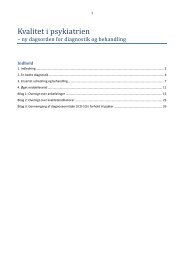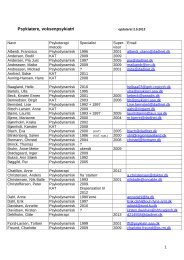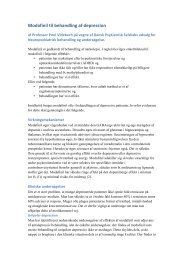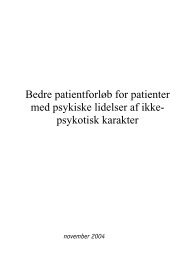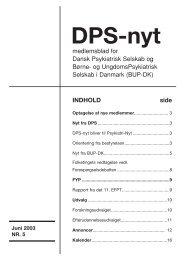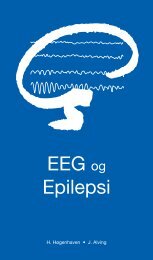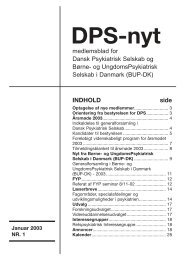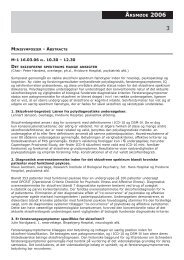Kvalitetsmåling i psykiatrien i de nordiske lande - Dansk Psykiatrisk ...
Kvalitetsmåling i psykiatrien i de nordiske lande - Dansk Psykiatrisk ...
Kvalitetsmåling i psykiatrien i de nordiske lande - Dansk Psykiatrisk ...
Create successful ePaper yourself
Turn your PDF publications into a flip-book with our unique Google optimized e-Paper software.
Proportion of inci<strong>de</strong>nt (diagnosed within 12 months of contact) patients for whom cognitive function was<br />
examined by a psychologist<br />
Proportion of inci<strong>de</strong>nt (diagnosed within 12 months of contact) patients for which need for social support has<br />
been assessed by a medical social worker, councellor, welfare officer, not medical social worker<br />
Proportion of inci<strong>de</strong>nt (diagnosed within 12 months of contact) patients examined for duration of untreated<br />
psychosis and who is treatet within 6 months after the first symptoms<br />
Proportion of outpatients with schizophrenia in contact with a specific member of the therapist team and/or<br />
for whom a psychotherapeutic course of treatment is implemented<br />
Proportion of patients with schizophrenia where relatives accept the offer of contact with the treatment<br />
system<br />
Proportion of children and adolescents with inci<strong>de</strong>nt schizophrenia receiving psychoeducation via a manualized<br />
course within 2 years of discharge<br />
Proportion of hospitalized patients assessed for suici<strong>de</strong> risk (documented in patient record) at discharge<br />
Proportion of patents with schizophrenia on anti-psychotic medication<br />
Proportion of outpatients with schizophrenia who receive more than one antipsychotic drug<br />
Proportion of outpatients with schizophtrenia receiving benzodiazepines with the exception of benxodiazepines<br />
(zolpi<strong>de</strong>m, zopiclon, zaleplon)<br />
Proportion of patients with a Global Assessment of Function (GAF) score of 30 days or less at discharge receiving<br />
social support measures in their home<br />
Proportion of patients discharged to an outpatient program<br />
Proportion of patients discharged to an outpatient program for whom an outpatients´ visit is registered within<br />
18 months of discharge<br />
Proportion of patients who have neurological si<strong>de</strong> effects<br />
Proportion of patients who have sleeping and sedation si<strong>de</strong> effects<br />
Proportion of patients who gain weight as a si<strong>de</strong> effect<br />
Proportion of patients who have sexual si<strong>de</strong> effects<br />
Proportion of patients who have an increased body mass in<strong>de</strong>x (BMI)<br />
Proportion of patients who have an increased waistline measure<br />
Proportion of patients who have an increased blood glucose level<br />
Proportion of patients who have an increased level of blood lipids<br />
Proportion of patients who have an increased blood pressure<br />
Generic indicators<br />
Proportion of psychiatric patients who are treated in the a psychiatric unit per. 100,000 inhabitants (Total)<br />
Proportion of psychiatric patients who are treated in the a psychiatric unit per. 100,000 inhabitants (Total) (age<br />
group: 0–17)<br />
Proportion of psychiatric patients who are treated in the a psychiatric unit per. 100,000 inhabitants (Total) (age<br />
group: 18–24)<br />
Proportion of psychiatric patients who are treated in the a psychiatric unit per. 100,000 inhabitants (Total) (age<br />
group: 25–44)<br />
Proportion of psychiatric patients who are treated in the a psychiatric unit per. 100,000 inhabitants (Total) (age<br />
group: 45–64)<br />
Proportion of psychiatric patients who are treated in the a psychiatric unit per. 100,000 inhabitants (Total) (age<br />
group: 65–84)<br />
Proportion of psychiatric patients who are treated in the a psychiatric unit per. 100,000 inhabitants (Total) (age<br />
group: 85+)<br />
Proportion of psychiatric patients who are treated in the a psychiatric unit per. 100,000 inhabitants (Men)<br />
Proportion of psychiatric patients who are treated in the a psychiatric unit per. 100,000 inhabitants (Men) (age<br />
group: 0–17)<br />
Proportion of psychiatric patients who are treated in the a psychiatric unit per. 100,000 inhabitants (Men) (age<br />
group: 18–24)<br />
Proportion of psychiatric patients who are treated in the a psychiatric unit per. 100,000 inhabitants (Men) (age<br />
group: 25–44)<br />
Proportion of psychiatric patients who are treated in the a psychiatric unit per. 100,000 inhabitants (Men) (age<br />
group: 45–64)<br />
Proportion of psychiatric patients who are treated in the a psychiatric unit per. 100,000 inhabitants (Men) (age<br />
group: 65–84)<br />
Proportion of psychiatric patients who are treated in the a psychiatric unit per. 100,000 inhabitants (Men) (age<br />
group: 85+)<br />
Proportion of psychiatric patients who are treated in the a psychiatric unit per. 100,000 inhabitants (Women)<br />
Proportion of psychiatric patients who are treated in the a psychiatric unit per. 100,000 inhabitants (Women)<br />
(age group: 0–17)<br />
Proportion of psychiatric patients who are treated in the a psychiatric unit per. 100,000 inhabitants (Women)<br />
(age group: 18–24)<br />
Proportion of psychiatric patients who are treated in the a psychiatric unit per. 100,000 inhabitants (Women)<br />
(age group: 25–44)<br />
Proportion of psychiatric patients who are treated in the a psychiatric unit per. 100,000 inhabitants (Women)<br />
(age group: 45–64)<br />
Proportion of psychiatric patients who are treated in the a psychiatric unit per. 100,000 inhabitants (Women)<br />
(age group: 65–84)<br />
186 Kvalitetsmåling i <strong>psykiatrien</strong>



